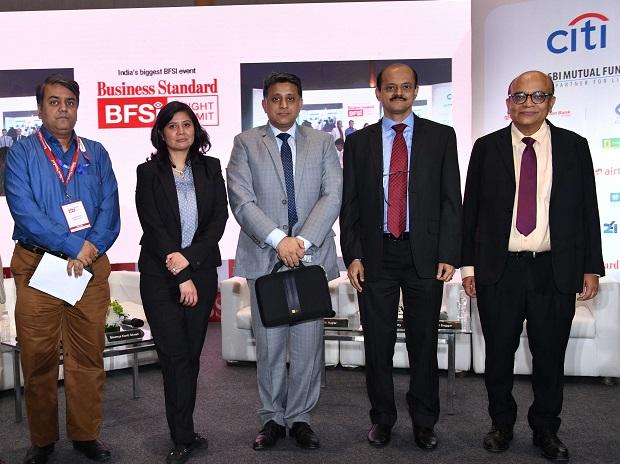[ad_1]
India has been relatively insulated from the severe headwinds in the West. However, with a third of the global economy expected to slip into recession in calendar year 2023, the impact will strongly be felt on India’s exports and trade economy, leading economists said in a panel discussion at the Business Standard BFSI Insight Summit in Mumbai on Wednesday.
The panel comprised former Reserve Bank of India executive director and former Monetary Policy Committee member Mridul Saggar, State Bank of India Chief Economic Advisor Soumya Kanti Ghosh, Citibank India Chief Economist Samiran Chakraborty, ICRA Chief Economist Aditi Nayar, and IndusInd Bank Chief Economist Gaurav Kapoor.
The topic of the panel discussion was No recession in sight: Is India decoupled from developed economies?
“We are quite coupled with the global economy. Our combined exports and imports stood at 44.9 per cent of GDP last year. This number is starkly higher than US or China. We are heavily integrated in terms of capital flows, trade, and financial channels. There is no way India can’t be hit. However, even if our growth slows down, it could still grow around 6 per cent next year,” Saggar said.
This view was echoed by his co-panelists. Citi’s Chakraborty said he expects global growth in 2023 to be around 2 per cent, but if one removes China, it will be around 0.5 per cent. “The US and Europe are around 38 per cent of India’s exports and both these places will have negative GDP growth. That way, impact on our exports will be more magnified than what simple global GDP growth numbers might suggest,” he said.
ICRA’s Nayar said there was concern regarding the intensity of the export crash next year, but she was optimistic that the demand sentiment in the economy was more positive that what the RBI surveys said. Nayar said the demand in the economy was not just the pent-up demand, and if it sustains, the domestic economy can absorb the hits from lower exports.
“There is limited degree of decoupling that we have managed to achieve. Important policy changes like inflation targeting have led to lower rupee depreciation and also lower inflation compared to the world,” said IndusInd’s Kapoor.
The International Monetary Fund in its latest World Economic Outlook has projected that a third of the global economy may slip into recession in calendar year 2023. In its October report, the IMF cut its forecast for global economic growth in calendar year 2023 by 0.2 percentage points to 2.7 per cent, with a 25 per cent probability that it could fall below 2 per cent.
Earlier this month, while the World Bank said India was relatively resilient compared to other major economies, it will still not be completely insulated from the spillovers from the US, Euro area, and China. For FY24, the World Bank cut India’s GDP forecast to 6.6 per cent from 7 per cent earlier.
Experts divided on further hikes
While two of the eminent panelists — Ghosh and Nayar — said they expect a pause in the monetary cycle by the MPC, Chakraborty, Sagar, and Kapoor said the MPC could still hike by 25-50 basis points.
“Food prices have behaved significantly better than expected. The MPC notes say both the external members have voted against the withdrawal of accommodative stance and have gone for a neutral stance. If the data shows what it does now, the chances are very low that rates will be hiked in the February policy meeting,” SBI’s Ghosh said.
In its December policy review, the MPC raised the repo rate by 35 bps, taking the cumulative quantum of rate hikes in 2022 to 225 bps. Retail inflation was at 5.88 per cent in November, marking the first time in 2022 that the price gauge was within the RBI’s 2-6 per cent tolerance zone. It has, however, remained above the RBI’s 4 per cent inflation target for 38 consecutive months.
“There is still scope for another 25-bp hike, given that the US Federal Reserve has said it will hike rates further,” Kapoor said. Chakraborty, meanwhile, said it was important to breaking the persistence of core inflation, which has remained sticky.
Expectations from Budget
The panelists were asked for their expectations from the 2023 Union Budget, which Finance Minister Nirmala Sitharaman is expected to present on February 1.
“I would like to see in the Budget in which revenues are being realistically estimated rather than conservatively estimated. Let us not prepare for a negative shock, let’s start spending early so that the fiscal multiplier is better. Regarding capital expenditure, we need to see better spending from states to get a better fiscal multiplier out of that,” Nayar said, correctly pointing out that the tax revenue growth projections in the 2021 and 2022 Union Budgets were rather conservative, thus giving the Centre a comfortable cushion to meet its deficit targets.
Ghosh said fiscal prudence would be a difficult exercise as 2024 will be an election year and the Centre’s medium-term fiscal deficit target is 4.5 per cent of GDP by 2025-26. “The good thing is that the revenue could be higher this year, so maybe it can reflect some sort of fiscal consolidation, as they may not want to go down very aggressively. My sense is that they may go down from 6.4 per cent to somewhat lower than 6 per cent but not too aggressively,” he said.
All the experts agreed that in spite of challenges and global headwinds, the India growth story remained a strong one, and it was still one of the fastest-growing major economies.
[ad_2]
Source link



